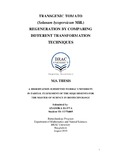Transgenic tomato (Solanum lycopersicum Mill.) regeneration by comparing different transformation techniques
Abstract
Production of saline-tolerant high-yielding crop has become most important in the current global scenario. Biotechnological approaches are extensively employed for introducing foreign genes into high-yielding genotypes. However, the success of genetic manipulation of a plant depends on the transformation as well as regeneration frequencies of the explants. This study presents a comparison of tissue-culture based and non-tissue-culture based transformation protocol for tomato (Solanum lycopersicum Mill.) using the Agrobacterium-mediated transformation of two different explants by three different vectors. Whole seed and cotyledonary leaves were used as explants of tomato varieties, named, BARI tomato-2, BARI tomato-3, BINA tomato-2, BINA tomato-3 and Bahar. Efficient and reproducible regeneration protocol was evaluated. Regeneration media with 2 mg/l BAP supplementation was found best for maximum number of shoot formation for all five varieties tested. For transformation, Agrobacterium tumefaciense strain LBA4404 harboring recombinant vectors, pBI121, pK7WG2_AtNHX1_1.6 and pK7WG2_OsNHX1_1.6 having kanamycin selectable marker gene were used. The parameters optimized here include optical density, infection time, co-cultivation period and pre-culturing of explants for all the varieties. In tissue-culture based transformation of cotyledonary leaves, transformation with bacterial solution (OD600 0.6-0.8) with infection time 30 min followed by 24 hrs of co-cultivation showed higher regeneration response under selection for all the varieties except BINA tomato-3 which gave its best result at OD600 1.0-1.2 with 48 hrs of co-cultivation period. Regeneration frequency of putative transformants appeared more than 35% under selection though the non-transformed plants gave more than 80% without selection (control experiment). This elaborate culture procedure resulted in low transformation frequency leading to necrosis of the regenerants, which urged to switch to the non-tissue-culture based transformation. During in planta transformation of whole seeds, OD600 1.1-1.4 with 30 minutes of incubation period and 24 hours of co-cultivation period was optimum for achieving more than 90% transformation efficiency in transient GUS expression for all the varieties. After optimization of in planta protocol by pBI121, the other vectors were employed for transformation. The vector pK7WG2_AtNHX1_1.6 has achieved maximum percentage of regeneration frequency over the other two vectors throughout the parameter optimization. Wounding of seeds resulted in reduction of germination percentage of infected seeds for all the tested varieties. The pre-culture period of 24 hours prior to infection were considered effective for regeneration of both explants. The process of transformant detection was carried out in three distinct ways, such as, antibiotic selection, GUS assay and leaf disc senescence assay. Kanamycin at a concentration of 50 mg/l found to be efficient for this purpose. In addition to bioassay, micropropagation of putative transformed leaves observed to regenerate during antibiotic selection confirms stable transformation. The percentage of transformation efficiency diverges with tomato genotype, explant, infecting vector and method of transformation. The in planta protocol ensured generation of putative transgenic plants with considerable ease in a short time and is not genotype-dependent. The putative transformed plants obtained from in planta transformation observed to tolerate upto 100 mM of salt. Successful transformation of tomato will be greatly aided by genotype-specific determination of crucial parameters on improving in vitro regeneration after transformation, followed by growth into a whole plant transformant through acclimatization to net house conditions. Further, the study offers independence to select suitable tomato variety, explant, vector and method of transformation to generate transgenic salt tolerant tomato.

